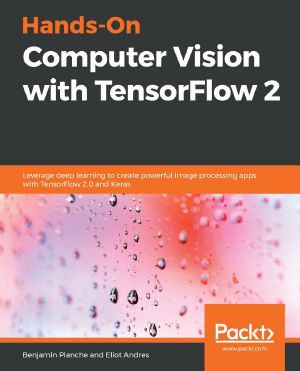Hands-On Computer Vision With Tensorflow

- Authors
- Planche, Benjamin
- Publisher
- Packt Publishing
- Tags
- com012050 - computers , image processing , com051360 - computers , programming languages , python , com016000 - computers , computer vision and pattern recognition
- Date
- 2019-05-30T00:00:00+00:00
- Size
- 19.94 MB
- Lang
- en
A practical guide to building high performance systems for object detection, segmentation, video processing, smartphone applications, and more.
Key Features:
• Discover how to build, train, and serve your own deep neural networks with TensorFlow 2 and Keras
• Apply modern solutions to a wide range of applications such as object detection and video analysis
• Learn how to run your models on mobile devices and webpages and improve their performance
Book Description:
Computer vision solutions are becoming increasingly common, making their way in fields such as health, automobile, social media, and robotics. This book will help you explore TensorFlow 2, the brand new version of Google's open source framework for machine learning. You will understand how to benefit from using convolutional neural networks (CNNs) for visual tasks.
Hands-On Computer Vision with TensorFlow 2 starts with the fundamentals of computer vision and deep learning, teaching you how to build a neural network from scratch. You will discover the features that have made TensorFlow the most widely used AI library, along with its intuitive Keras interface, and move on to building, training, and deploying CNNs efficiently. Complete with concrete code examples, the book demonstrates how to classify images with modern solutions, such as Inception and ResNet, and extract specific content using You Only Look Once (YOLO), Mask R-CNN, and U-Net. You will also build Generative Adversarial Networks (GANs) and Variational Auto-Encoders (VAEs) to create and edit images, and LSTMs to analyze videos. In the process, you will acquire advanced insights into transfer learning, data augmentation, domain adaptation, and mobile and web deployment, among other key concepts.
By the end of the book, you will have both the theoretical understanding and practical skills to solve advanced computer vision problems with TensorFlow 2.0.
What you will learn:
• Create your own neural networks from scratch
• Classify images with modern architectures including Inception and ResNet
• Detect and segment objects in images with YOLO, Mask R-CNN, and U-Net
• Tackle problems in developing self-driving cars and facial emotion recognition systems
• Boost your application’s performance with transfer learning, GANs, and domain adaptation
• Use recurrent neural networks for video analysis
• Optimize and deploy your networks on mobile devices and in the browser
Who this book is for:
If you’re new to deep learning and have some background in Python programming and image processing, like reading/writing image files and editing pixels, this book is for you. Even if you’re an expert curious about the new TensorFlow 2 features, you’ll find this book useful.
While some theoretical explanations require knowledge in algebra and calculus, the book covers concrete examples for learners focused on practical applications such as visual recognition for self-driving cars and smartphone apps.